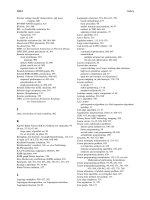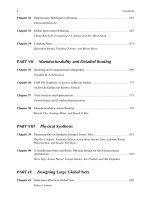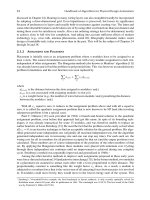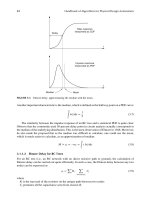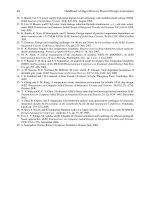Algorithms for VLSI physical design automation, 3e
Bạn đang xem bản rút gọn của tài liệu. Xem và tải ngay bản đầy đủ của tài liệu tại đây (23.92 MB, 600 trang )
eBook ISBN:
Print ISBN:
0-306-47509-X
0-7923-8393-1
©2002 Kluwer Academic Publishers
New York, Boston, Dordrecht, London, Moscow
Print ©1999 Kluwer Academic Publishers
Dordrecht
All rights reserved
No part of this eBook may be reproduced or transmitted in any form or by any means, electronic,
mechanical, recording, or otherwise, without written consent from the Publisher
Created in the United States of America
Visit Kluwer Online at:
and Kluwer's eBookstore at:
ALGORITHMS FOR VLSI
PHYSICAL DESIGN AUTOMATION
THIRD EDITION
Naveed A. Sherwani
Intel Corporation.
KLUWER ACADEMIC PUBLISHERS
NEW YORK, BOSTON, DORDRECHT, LONDON, MOSCOW
This Page Intentionally Left Blank
ALGORITHMS FOR VLSI
PHYSICAL DESIGN AUTOMATION
THIRD EDITION
To my parents
Akhter and Akram Sherwani
Contents
Foreword
Preface
Acknowledgements
xvii
xix
xxvii
1 VLSI Physical Design Automation
1.1 VLSI Design Cycle
1.2 New Trends in VLSI Design Cycle
1.3 Physical Design Cycle
1.4 New Trends in Physical Design Cycle
1.5 Design Styles
1.5.1 Full-Custom
1.5.2 Standard Cell
1.5.3 Gate Arrays
1.5.4 Field Programmable Gate Arrays
1.5.5 Sea of Gates
1.5.6 Comparison of Different Design Styles
1.6 System Packaging Styles
1.6.1 Die Packaging and Attachment Styles
1.6.1.1 Die Package Styles
1.6.1.2 Package and Die Attachment Styles
1.6.2 Printed Circuit Boards
1.6.3 Multichip Modules
1.6.4 Wafer Scale Integration
1.6.5 Comparison of Different Packaging Styles
1.7 Historical Perspectives
1.8 Existing Design Tools
1.9 Summary
1
3
7
9
13
15
17
18
20
22
25
25
26
26
26
27
27
29
31
31
32
33
35
2 Design and Fabrication of VLSI Devices
2.1 Fabrication Materials
2.2 Transistor Fundamentals
2.2.1 Basic Semiconductor Junction
2.2.2 TTL Transistors
39
40
43
43
45
viii
Contents
2.2.3 MOS Transistors
2.3 Fabrication of VLSI Circuits
2.3.1 nMOS Fabrication Process
2.3.2 CMOS Fabrication Process
2.3.3 Details of Fabrication Processes
2.4 Design Rules
2.5 Layout of Basic Devices
2.5.1 Inverters
2.5.2 NAND and NOR Gates
2.5.3 Memory Cells
2.5.3.1 Static Random Access Memory (SRAM)
2.5.3.2 Dynamic Random Access Memory (DRAM)
2.6 Summary
2.7 Exercises
3 Fabrication Process and its Impact on Physical Design
3.1 Scaling Methods
3.2 Status of Fabrication Process
3.2.1 Comparison of Fabrication Processes
3.3 Issues related to the Fabrication Process
3.3.1 Parasitic Effects
3.3.2 Interconnect Delay
3.3.3 Noise and Crosstalk
3.3.4 Interconnect Size and Complexity
3.3.5 Other Issues in Interconnect
3.3.6 Power Dissipation
3.3.7 Yield and Fabrication Costs
3.4 Future of Fabrication Process
3.4.1 SIA Roadmap
3.4.2 Advances in Lithography
3.4.3 Innovations in Interconnect
3.4.3.1 More Layers of Metal
3.4.3.2 Local Interconnect
3.4.3.3 Copper Interconnect
3.4.3.4 Unlanded Vias
3.4.4 Innovations/Issues in Devices
3.4.5 Aggressive Projections for the Process
3.4.6 Other Process Innovations
3.4.6.1 Silicon On Insulator
3.4.6.2 Silicon Germaniun
3.5 Solutions for Interconnect Issues
3.6 Tools for Process Development
3.7 Summary
3.8 Exercises
46
48
51
53
53
58
62
62
64
66
67
69
71
71
75
76
77
77
79
79
80
81
82
82
82
83
85
85
86
87
87
87
87
88
88
89
90
90
90
91
93
94
94
Contents
4 Data Structures and Basic Algorithms
4.1 Basic Terminology
4.2 Complexity Issues and NP-hardness
4.2.1 Algorithms for NP-hard Problems
4.2.1.1 Exponential Algorithms
4.2.1.2 Special Case Algorithms
4.2.1.3 Approximation Algorithms
4.2.1.4 Heuristic Algorithms
4.3 Basic Algorithms
4.3.1 Graph Algorithms
4.3.1.1 Graph Search Algorithms
4.3.1.2 Spanning Tree Algorithms
4.3.1.3 Shortest Path Algorithms
4.3.1.4 Matching Algorithms
4.3.1.5 Min-Cut and Max-Cut Algorithms
4.3.1.6 Steiner Tree Algorithms
4.3.2 Computational Geometry Algorithms
4.3.2.1 Line Sweep Method
4.3.2.2 Extended Line Sweep Method
4.4 Basic Data Structures
4.4.1 Atomic Operations for Layout Editors
4.4.2 Linked List of Blocks
4.4.3 Bin-Based Method
4.4.4 Neighbor Pointers
4.4.5 Corner Stitching
4.4.6 Multi-layer Operations
4.4.7 Limitations of Existing Data Structures
4.4.8 Layout Specification Languages
4.5 Graph Algorithms for Physical design
4.5.1 Classes of Graphs in Physical Design
4.5.1.1 Graphs Related to a Set of Lines
4.5.1.2 Graphs Related to Set of Rectangles
4.5.2 Relationship Between Graph Classes
4.5.3 Graph Problems in Physical Design
4.5.4 Algorithms for Interval Graphs
4.5.4.1 Maximum Independent Set
4.5.4.2 Maximum Clique and Minimum Coloring
4.5.5 Algorithms for Permutation Graphs
4.5.5.1 Maximum Independent Set
4.5.5.2 Maximum -Independent Set
4.5.6 Algorithms for Circle Graphs
4.5.6.1 Maximum Independent Set
4.5.6.2 Maximum -Independent Set
4.5.6.3 Maximum Clique
4.6 Summary
4.7 Exercises
ix
97
99
100
101
102
102
102
103
104
104
104
106
108
110
110
111
115
115
115
117
117
119
120
122
123
130
131
131
135
135
136
138
138
140
142
142
143
144
144
146
148
148
149
151
151
152
Contents
x
5
Partitioning
5.1 Problem Formulation
5.1.1 Design Style Specific Partitioning Problems
5.2 Classification of Partitioning Algorithms
5.3 Group Migration Algorithms
5.3.1 Kernighan-Lin Algorithm
5.3.2 Extensions of Kernighan-Lin Algorithm
5.3.2.1 Fiduccia-Mattheyses Algorithm
5.3.2.2 Goldberg and Burstein Algorithm
5.3.2.3 Component Replication
5.3.2.4 Ratio Cut
5.4 Simulated Annealing and Evolution
5.4.1 Simulated Annealing
5.4.2 Simulated Evolution
5.5 Other Partitioning Algorithms
5.5.1 Metric Allocation Method
5.6 Performance Driven Partitioning
5.7 Summary
5.8 Exercises
6 Floorplanning and Pin Assignment
6.1 Floorplanning
6.1.1 Problem Formulation
6.1.1.1 Design Style Specific Floorplanning Problems
6.1.2 Classification of Floorplanning Algorithms
6.1.3 Constraint Based Floorplanning
6.1.4 Integer Programming Based Floorplanning
6.1.5 Rectangular Dualization
6.1.6 Hierarchical Tree Based Methods
6.1.7 Floorplanning Algorithms for Mixed Block and Cell Designs
6.1.8 Simulated Evolution Algorithms
6.1.9 Timing Driven Floorplanning
6.1.10 Theoretical advancements in Floorplanning
6.1.11 Recent Trends
6.2 Chip planning
6.2.1 Problem Formulation
6.3 Pin Assignment
6.3.1 Problem Formulation
6.3.1.1 Design Style Specific Pin Assignment Problems
6.3.2 Classification of Pin Assignment Algorithms
6.3.3 General Pin Assignment
6.3.4 Channel Pin Assignment
6.4 Integrated Approach
6.5 Summary
6.6 Exercises
157
163
166
168
169
170
171
173
174
174
176
177
177
179
183
183
185
187
187
191
193
193
194
194
196
198
200
201
203
203
204
205
206
207
207
207
208
208
209
210
211
214
217
217
Contents
7 Placement
7.1 Problem Formulation
7.1.1 Design Style Specific Placement Problems
7.2 Classification of Placement Algorithms
7.3 Simulation Based Placement Algorithms
7.3.1 Simulated Annealing
7.3.2 Simulated Evolution
7.3.3 Force Directed Placement
7.3.4 Sequence-Pair Technique
7.3.5 Comparison of Simulation Based Algorithms
Partitioning Based Placement Algorithms
7.4.1 Breuer’s Algorithm
7.4.2 Terminal Propagation Algorithm
7.5 Other Placement Algorithms
7.5.1 Cluster Growth
7.5.2 Quadratic Assignment
7.5.3 Resistive Network Optimization
7.5.4 Branch-and-Bound Technique
7.6 Performance Driven Placement
7.7 Recent Trends
7.8 Summary
7.9 Exercises
7.4
8 Global Routing
8.1 Problem Formulation
8.1.1 Design Style Specific Global Routing Problems
8.2 Classification of Global Routing
Algorithms
8.3 Maze Routing Algorithms
8.3.1 Lee’s Algorithm
8.3.2 Soukup’s Algorithm
8.3.3 Hadlock’s Algorithm
8.3.4 Comparison of Maze Routing Algorithms
8.4 Line-Probe Algorithms
8.5 Shortest Path Based Algorithms
8.6 Steiner Tree based Algorithms
8.6.1 Separability Based Algorithm
8.6.2 Non-Rectilinear Steiner Tree Based Algorithm
8.6.3 Steiner Min-Max Tree based Algorithm
8.6.4 Weighted Steiner Tree based Algorithm
8.7 Integer Programming Based Approach
8.7.1 Hierarchical Approach
8.8 Performance Driven Routing
8.9 Summary
8.10 Exercises
xi
219
220
223
225
225
226
229
232
233
233
236
236
236
239
240
240
241
241
242
242
243
244
244
247
253
257
260
261
261
263
264
267
269
272
273
274
277
279
281
282
282
286
287
288
xii
Contents
9 Detailed Routing
9.1 Problem Formulation
9.1.1 Routing Considerations
9.1.2 Routing Models
9.1.3 Channel Routing Problems
9.1.4 Switchbox Routing Problems
9.1.5 Design Style Specific Detailed Routing Problems
9.2 Classification of Routing Algorithms
9.3 Single-Layer Routing Algorithms
9.3.1 General River Routing Problem
9.3.1.1 General River Routing Algorithm
9.3.2 Single Row Routing Problem
9.3.2.1 Origin of Single Row Routing
9.3.2.2 A Graph Theoretic Approach
9.3.2.3 Algorithm for Street Congestion Minimization
9.3.2.4 Algorithm for Minimizing Doglegs
9.4 Two-Layer Channel Routing Algorithms
9.4.1 Classification of Two-Layer Algorithms
9.4.2 LEA based Algorithms
9.4.2.1 Basic Left-Edge Algorithm
9.4.2.2 Dogleg Router
9.4.2.3 Symbolic Channel Router: YACR2
9.4.3 Constraint Graph based Routing Algorithms
9.4.3.1 Net Merge Channel Router
9.4.3.2 Glitter: A Gridless Channel Router
9.4.4 Greedy Channel Router
9.4.5 Hierarchical Channel Router
9.4.6 Comparison of Two-Layer Channel Routers
9.5 Three-Layer Channel Routing Algorithms
9.5.1 Classification of Three-Layer Algorithms
9.5.2 Extended Net Merge Channel Router
9.5.3 HVH Routing from HV Solution
9.5.4 Hybrid HVH-VHV Router
9.6 Multi-Layer Channel Routing Algorithms
9.7 Switchbox Routing Algorithms
9.7.1 Classification of switchbox routing algorithms
9.7.2 Greedy Router
9.7.3 Rip-up and Re-route Based Router
9.7.4 Computational Geometry Based Router
9.7.5 Comparison of Switchbox Routers
9.8 Summary
9.9 Exercises
291
293
293
295
297
302
302
303
304
306
306
311
312
316
316
318
320
320
321
321
323
325
329
330
334
338
340
345
345
346
346
348
349
352
353
354
355
358
358
362
362
363
Contents
xiii
10 Over-the-Cell Routing and Via Minimization
10.1 Over-the-cell Routing
10.1.1 Cell Models
10.1.2 Two-Layer Over-the-Cell Routers
10.1.2.1 Basic OTC Routing Algorithm
10.1.2.2 Planar Over-the-Cell Routing
10.1.2.3 Over-the-Cell Routing Using Vacant Terminals
10.1.3 Three-Layer Over-the-cell Routing
10.1.4 Multilayer OTC Routing
10.1.5 Performance Driven Over-the-cell Routing
10.2 Via Minimization
10.2.1 Constrained Via Minimization Problem
10.2.1.1 Graph Representation of Two-Layer CVM Problem
10.2.2 Unconstrained Via Minimization
10.2.2.1 Optimal Algorithm for Crossing-Channel TVM
Problem
10.2.2.2 Approximation Result for General k-TVM Problem
10.2.2.3 Routing Based on Topological Solution
10.3 Summary
10.4 Exercises
369
370
371
373
373
377
389
396
398
398
400
401
11 Clock and Power Routing
11.1 Clock Routing
11.1.1 Clocking Schemes
11.1.2 Design Considerations for the Clocking System
11.1.2.1 Delay Calculation for Clock Trees
Problem
Formulation
11.1.3
11.1.3.1 Design Style Specific Problems
11.1.4 Clock Routing Algorithms
11.1.4.1 H-tree Based Algorithm
11.1.4.2 The MMM Algorithm
11.1.4.3 Geometric Matching based Algorithm
11.1.4.4 Weighted Center Algorithm
11.1.4.5 Exact Zero Skew Algorithm
11.1.4.6 DME Algorithm
11.1.5 Skew and Delay Reduction by Pin Assignment
11.1.6 Multiple Clock Routing
11.2 Power and Ground Routing
11.3 Summary
11.4 Exercises
417
418
419
422
423
426
427
427
428
429
430
432
433
436
439
439
440
444
444
403
407
408
409
410
410
411
xiv
Contents
12 Compaction
12.1 Problem Formulation
12.1.1 Design Style Specific Compaction Problem
12.2 Classification of Compaction Algorithms
12.3 One-Dimensional Compaction
12.3.1 Constraint-Graph Based Compaction
12.3.1.1 Constraint Graph Generation
12.3.1.2 Critical Path Analysis
12.3.1.3 Wire Jogging
12.3.1.4 Wire Length Minimization
12.3.2 Virtual Grid Based Compaction
12.3.2.1 Basic Virtual Grid Algorithm
12.3.2.2 Split Grid Compaction
12.3.2.3 Most Recent Layer Algorithm
Compaction
12.4
12.5 Two-Dimensional Compaction
12.5.1 Simulated Annealing based Algorithm
12.6 Hierarchical Compaction
12.6.1 Constraint-Graph Based Hierarchical Compaction
12.7 Recent trends in compaction
12.7.1 Performance-driven compaction
12.7.2 Compaction techniques for yield enhancement
12.8 Summary
12.9 Exercises
449
450
450
451
452
453
454
460
463
463
463
464
464
467
468
470
473
473
473
474
474
475
476
476
13 Physical Design Automation of FPGAs
13.1 FPGA Technologies
13.2 Physical Design Cycle for FPGAs
13.3 Partitioning
13.4 Routing
13.4.1 Routing Algorithm for the Non-Segmented Model
13.4.2 Routing Algorithms for the Segmented Model
13.4.2.1 Basic Algorithm
13.4.2.2 Routing Algorithm for Staggered Model
13.5 Summary
13.6 Exercises
479
480
485
485
489
490
492
493
494
496
497
14 Physical Design Automation of MCMs
14.1 MCM Technologies
14.2 MCM Physical Design Cycle
14.3 Partitioning
14.4 Placement
14.4.1 Chip Array Based Approach
14.4.2 Full Custom Approach
14.5 Routing
14.5.1 Classification of MCM Routing Algorithms
501
502
505
507
510
512
512
513
514
Contents
xv
14.5.2 Maze Routing
14.5.3 Multiple Stage Routing
14.5.3.1 Pin Redistribution Problem
14.5.3.2 Layer Assignment
14.5.3.3 Detailed Routing
14.5.4 Topological Routing
14.5.5 Integrated Pin Distribution and Routing
14.5.6 Routing in Programmable Multichip Modules
14.6 Summary
14.7 Exercises
514
515
515
517
517
517
519
519
521
521
Bibliography
525
Author Index
563
Subject Index
567
This Page Intentionally Left Blank
Foreword
Since the invention of integrated circuits thirty years ago, manufacturing of
electronic systems has taken rapid strides in improvement in speed, size, and
cost. For today’s integrated circuit chips, switching time is on the order of
nanoseconds, minimum feature size is on the order of sub-microns, transistor
count is on the order of millions, and cost is on the order of a few dollars.
In fact, it was estimated that the performance/cost ratio of integrated circuit
chips has been increasing at the rate of one thousand-fold every ten years,
yielding a total of
for the last three decades. A combination of high product
performance and low per-unit cost leads to the very pervasive introduction of
integrated circuit chips to many aspects of modern engineering and scientific
endeavors including computations, telecommunications, aeronautics, genetics,
bioengineering, manufacturing, factory automation, and so on. It is clear that
the integrated circuit chip will play the role of a key building block in the
information society of the twenty-first century.
The manufacture of integrated circuit chips is similar to the manufacture
of other highly sophisticated engineering products in many ways. The three
major steps are designing the product, fabricating the product, and testing the
fabricated product. In the design step, a large number of components are to
be designed or selected, specifications on how these components should be assembled are to be made, and verification steps are to be carried out to assure
the correctness of the design. In the manufacturing step, a great deal of manpower, and a large collection of expensive equipment, together with painstaking
care are needed to assemble the product according to the design specification.
Finally, the fabricated product must be tested to check its physical functionality. As in all engineering problems, there are conflicting requirements in all
these steps. In the design step, we want to obtain an optimal product design,
and yet we also want the design cycle to be short. In the fabrication step, we
want the product yield to be high, and yet we also need to be able to produce
a large volume of the product and get them to market in time. In the testing
step, we want the product to be tested thoroughly and yet we also want to be
able to do so quickly.
The title of this book reveals how the issue of enormous design complexity
is to be handled so that high quality designs can be obtained in a reasonable amount of design time: We use muscles (automation) and we use brain
xviii
(algorithms). Professor Sherwani has written an excellent book to introduce
students in computer science and electrical engineering as well as CAD engineers to the subject of physical design of VLSI circuits. Physical design is a
key step in the design process. Research and development efforts in the last
twenty years have led us to some very good understanding on many of the
important problems in physical design. Professor Sherwani’s book provides a
timely, up-to-date integration of the results in the field and will be most useful
both as a graduate level textbook and as a reference for professionals in the
field. All aspects of the physical design process are covered in a meticulous
and comprehensive manner. The treatment is enlightening and enticing. Furthermore, topics related to some of the latest technology developments such as
Field Programmable Gate Arrays (FPGA) and Multi-Chip Modules (MCM)
are also included. A strong emphasis is placed on the algorithmic aspect of
the design process. Algorithms are presented in an intuitive manner without
the obscurity of unnecessary formalism. Both theoretical and practical aspects
of algorithmic design are stressed. Neither the elegance of optimal algorithms
nor the usefulness of heuristic algorithms are overlooked. ¿From a pedagogical
point of view, the chapters on electronic devices and on data structures and basic algorithms provide useful background material for students from computer
science, computer engineering, and electrical engineering. The many exercises
included in the book are also most helpful teaching aids.
This is a book on physical design algorithms. Yet, this is a book that
goes beyond physical design algorithms. There are other important design
steps of which our understanding is still quite limited. Furthermore, development of new materials, devices, and technologies will unquestionably create new
problems and new avenues of research and development in the design process.
An algorithmic outlook on design problem and the algorithmic techniques for
solving complex design problems, which a reader learns through the examples
drawn from physical design in this book, will transcend the confine of physical
design and will undoubtedly prepare the reader for many of the activities in
the field of computer-aided design of VLSI circuits. I expect to hear from many
students and CAD professionals in the years to come that they have learned a
great deal about physical design, computer-aided design, and scientific research
from Professor Sherwani’s book. I also expect to hear from many of them that
Professor Sherwani’s book is a source of information as well as a source of inspiration.
Urbana-Champaign, September 1992
C. L. Liu
Preface
From its humble beginning in the early 1950’s to the manufacture of circuits
with millions of components today, VLSI design has brought the power of the
mainframe computer to the laptop. Of course, this tremendous growth in the
area of VLSI design is made possible by the development of sophisticated design
tools and software. To deal with the complexity of millions of components and
to achieve a turn around time of a couple of months, VLSI design tools must
not only be computationally fast but also perform close to optimal.
The future growth of VLSI systems depends critically on the research and
development of Physical Design (PD) Automation tools. In the last two decades,
the research in physical design automation has been very intense, and literally
thousands of research articles covering all phases of physical design automation
have been published. The development of VLSI physical design automation also
depends on availability of trained manpower. We have two types of students
studying VLSI physical design: students preparing for a research career and
students preparing for a career in industry. Both types of students need to
build a solid background. However, currently we lack courses and text books
which give students a comprehensive background. It is common to find students doing research in placement, but are unaware of the latest developments
in compaction. Those students seeking careers in industry will find that the
VLSI physical design industry is very fast paced. They are expected to be conversant with existing tools and algorithms for all the stages of the design cycle
of a VLSI chip. In industry, it is usual to find CAD engineers who work on one
aspect of physical design and lack knowledge of other aspects. For example,
a CAD engineer working in the development of detailed routers may not be
knowledgeable about partitioning algorithms. This is again due to the lack
of comprehensive textbooks which cover background material in all aspects of
VLSI physical design.
Providing a comprehensive background in one textbook in VLSI physical
design is indeed difficult. This is due to the fact that physical design automation requires a mix of backgrounds. Some electrical engineering and a solid
undergraduate computer science background is necessary to grasp the fundamentals. In addition, some background in graph theory and combinatorics is
also needed, since many of the algorithms are graph theoretic or use other
combinatorial optimization techniques. This mix of backgrounds has perhaps
xx
restricted the development of courses and textbooks in this very area.
This book is an attempt to provide a comprehensive background in the
principles and algorithms of VLSI physical design. The goal of this book is to
serve as a basis for the development of introductory level graduate courses in
VLSI physical design automation. It is hoped that the book provides self contained material for teaching and learning algorithms of physical design. All
algorithms which are considered basic have been included. The algorithms are
presented in an intuitive manner, so that the reader can concentrate on the
basic idea of the algorithms. Yet, at the same time, enough detail is provided
so that readers can actually implement the algorithms given in the text and
use them.
This book grew out of a graduate level class in VLSI physical design automation at Western Michigan University. Initially written as a set of class
notes, the book took form as it was refined over a period of three years.
Overview of the Book
This book covers all aspects of physical design. The first three chapters
provide the background material, while the focus of each chapter of the rest
of the book is on each phase of the physical design cycle. In addition, newer
topics like physical design automation of FPGAs and MCMs have also been
included.
In Chapter 1, we give an overview of the VLSI physical design automation
field. Topics include the VLSI design cycle, physical design cycle, design styles
and packaging styles. The chapter concludes with a brief historical review of
the field.
Chapter 2 discusses the fabrication process for VLSI devices. It is important
to understand the fabrication technology in order to correctly formulate the
problems. In addition, it is important for one to understand, what is doable
and what is not! Chapter 2 presents fundamentals of MOS and TTL transistors.
It then describes simple NAND and NOR gates in nMOS and CMOS.
Chapter 3 presents the status of fabrication process, as well as, process
innovations on the horizons and studies its impact on physical design. We also
discuss several other factors such as design rules, yield, delay, and fabrication
costs involved in the VLSI process.
Basic material on data structures and algorithms involved in the physical
design is presented in Chapter 4. Several different data structures for layout
have been discussed. Graphs which are used to model several different problems
in VLSI design are defined and basic algorithms for these graphs are presented.
Chapter 5 deals with partitioning algorithms. An attempt has been made
to explain all the possible factors that must be considered in partitioning the
VLSI circuits. Group migration, simulated annealing and simulated evolution
algorithms have been presented in detail. The issue of performance driven
partitioning is also discussed.
In Chapter 6, we discuss basic algorithms for floorplanning and pin assignment. Several different techniques for placement such as, simulated annealing,
xxi
simulated evolution, and force-directed are discussed in Chapter 7.
Chapter 8 deals with global routing. It covers simple routing algorithms,
such as maze routing, and more advanced integer programming based methods.
It also discusses Steiner tree algorithms for routing of multiterminal nets.
Chapter 9 is the longest chapter in the book and represents the depth
of knowledge that has been gained in the detailed routing area in the last
decade. Algorithms are classified according to the number of layers allowed for
routing. In single layer routing, we discuss general river routing and the single
row routing problem. All major two-layer channel and switch box routers are
also presented. The chapter also discusses three-layer and multilayer routing
algorithms.
Chapter 10 discusses two ways of improving layouts after detailed routing,
namely, via minimization and over-the-cell routing. Basic algorithms for via
minimization are presented. Over-the-cell routing is a relatively new technique
for reducing routing areas. We present the two latest algorithms for over-thecell routing.
The problems of routing clock and power/ground nets are discussed in
Chapter 11. These topics play a key role in determining the layout of high
performance systems. Circuit compaction is discussed in Chapter 12. One dimensional compaction, as well as two dimensional compaction algorithms are
presented.
Field Programmable Gate Arrays (FPGAs) are rapidly gaining ground in
many applications, such as system prototyping. In Chapter 13, we discuss
physical design automation problems and algorithms for FPGAs. In particular,
we discuss the partitioning and routing problems in FPGAs. Both of these
problems are significantly different from problems in VLSI. Many aspects of
physical design of FPGAs remain a topic of current research.
Multi-Chip Modules (MCMs) are replacing conventional printed circuit
boards in many applications. MCMs promise high performance systems at
a lower cost. In Chapter 14, we explore the physical design issues in MCMs. In
particular, the routing problem of MCMs is a true three dimensional problem.
MCMs are currently a topic of intense research.
At the end of each chapter, a list of exercises is provided, which range in
complexity from simple to research level. Unmarked problems and algorithms
are the simplest. The exercises marked with (†) are harder and algorithms in
these exercises may take a significant effort to implement. The exercises and
algorithms marked with (‡) are the hardest. In fact, some of these problems
are research problems.
Bibliographic notes can be found at the end of each chapter. In these notes,
we give pointers to the readers for advanced topics. An extensive bibliography
is presented at the end of the text. This bibliography is complete, to the best
of our knowledge, up to the September of 1998. An attempt has been made to
include all papers which are appropriate for the targeted readers of this text.
The readers may also find the author and the subject index at the back of the
text.
xxii
Overview of the Second Edition
In 1992, when this book was originally published, the largest microprocessor
had one million transistors and fabrication process had three metal layers. We
have now moved into a six metal layer process and 15 million transistor microprocessors are already in advanced stages of design. The designs are moving
towards a 500 to 700 Mhz frequency goal. This challenging frequency goal, as
well as, the additional metal layers have significantly altered the VLSI field.
Many issues such as three dimensional routing, Over-the-Cell routing, early
floorplanning have now taken a central place in the microprocessor physical
design flow. This changes in the VLSI design prompted us to reflect these in
the book. That gave birth to the idea of the second edition.
The basic purpose of the second edition is to introduce a more realistic
picture to the reader exposing the concerns facing the VLSI industry while
maintaining the theoretical flavor of the book. New material has been added
to all the chapters. Several new sections have been added to many chapters.
Few chapters have been completely rewritten. New figures have been added to
supplement the new material and clarify the existing material.
In summary, I have made an attempt to capture the physical design flow
used in the industry and present it in the second addition. I hope that readers
will find that information both useful and interesting.
Overview of the Third Edition
In 1995, when we prepared the 2nd edition of this book, a six metal layer
process and 15 million transistor microprocessors were in advanced stages of
design. In 1998, six metal process and 20 million transistor designs are in production. Several manufacturers have moved to 0.18 micron process and copper
interconnect. One company has announced plans for 0.10 micron process and
plans to integrate 200 to 400 million transistors on a chip. Operating frequency
has moved from 266 Mhz (in 1995) to 650 Mhz and several Ghz experimental
chips have been demonstrated. Interconnect delay has far exceeded device delay and has become a dominant theme in physical design. Process innovations
such as copper, low k dielectrics, multiple threshold devices, local interconnect
are once again poised to change physical design once again.
The basic purpose of the third edition is to investigate the new challenges
presented by interconnect and process innovations. In particular, we wanted to
identify key problems and research areas that physical design community needs
to invest in order to meet the challenges. We took a task of presenting those
ideas while maintaining the flavor of the book. As a result, we have added two
new chapters and new material has been added to most of the chapters. A new
chapter on process innovation and its impact on physical design has been added.
Another focus of the book has been to promote use of Internet as a resource,
so wherever possible URLs has been provided for further investigation.
Chapters 1 and 2 have been updated. Chapter 3 is a new chapter on the
fabrication process and its impact. Chapter 4 (algorithms) and Chapter 5
xxiii
(partitioning) have been edited for clarity. Chapter on Floorplanning, Placement and Pin Assignment has been split into Chapter 6 (Floorplanning) and
Chapter 7 (Placement) to bring sharper focus to floorplanning. New sequence
pair algorithms have been added to Chapter 7 (Placement) Chapter 8 and 9
have been edited for clarity and references have been updated as appropriate.
New sections have been added to Chapter 10, Chapter 11 and Chapter 12. In
Chapter 10, we have added material related to performance driven routing. In
Chapter 11, DME algorithm has been added. In Chapter 12, we have added
new compaction algorithms. Chapters 13 (FPGAs) and 14 (MCMs) have been
updated. We have made an attempt to update the bibliography quite extensively and many new items have been added.
In summary, I have made an attempt to capture the impact of interconnect
and process innovations on physical design flow. I have attempted to balance
material on new innovations with the classical content of the 2nd edition. I
hope that readers will find that information both useful and interesting.
To the Teacher
This book has been written for introductory level graduate students. It
presents concepts and algorithms in an intuitive manner. Each chapter contains
3 to 4 algorithms that have been discussed in detail. This has been done so as
to assist students in implementing the algorithms. Other algorithms have been
presented in a somewhat shorter format. References to advanced algorithms
have been presented at the end of each chapter. Effort has been made to make
the book self contained.
This book has been developed for a one-semester or a two-semester course
in VLSI physical design automation. In a one-semester course, it is recommended that chapters 8, 9, 11, and 12 be omitted. A half-semester algorithm
development project is highly recommended. Implementation of algorithms is
an important tool in making students understand algorithms. In physical design, the majority of the algorithms are heuristic in nature and testing of these
algorithms on benchmarks should be stressed. In addition, the development of
practical algorithms must be stressed, that is, students must be very aware of
the complexity of the algorithms. An optimal
algorithm may be impractical for an input of size 10 million. Several (†) marked problems at the end of
each chapter may serve as mini-projects.
In a two-semester class, it is recommended that all the chapters be included.
Reading state-of-art papers must be an integral part of this class. In particular,
students may be assigned papers from proceedings of DAC and ICCAD or
from IEEE Transactions on CAD. Papers from Transactions typically require
a little more mathematical maturity than the papers in DAC and ICCAD. An
important part of this class should be a two-semester project, which may be
the development of a new algorithm for some problem in physical design. A
typical first part of the project may involve modifying an existing algorithm
for a special application. Some (‡) problems may serve as projects.
In both the courses, a good background in hand layout is critical. It is
xxiv
expected that students will have access to a layout editor, such as MAGIC or
LEDIT. It is very important that students actually layout a few small circuits.
For examples see exercises at the end of Chapter 2.
For faculty members, a teaching aid package, consisting of a set of 400 overheads (foils) is available from the author. These are quite helpful in teaching
the class, as all the important points have been summarized on section by section basis. In order to obtain these foils, please send an email (or a mail) to
the author, at the address below.
To the Student
First and foremost, I hope that you will enjoy reading this book. Every
effort has been made to make this book easy to read. The algorithms have
been explained in an intuitive manner. The idea is to get you to develop new
algorithms at the end of the semester. The book has been balanced to give
a practical as well as a theoretical background. In that sense, you will find
it useful, if you are thinking about a career in industry or if you are thinking
about physical design as a possible graduate research topic.
What do you need to start reading this book? Some maturity in general
algorithm techniques and data structures is assumed. Some electrical engineering background and mathematics background will be helpful, although not
necessary. The book is self-contained to a great extent and does not need any
supporting text or reference text.
If you are considering a career in this field, I have one important piece of
advise for you. Research in this field moves very fast. As a result, no textbook
can replace state-of-the-art papers. It is recommended that you read papers
to keep you abreast of latest developments. A list of conference proceedings
and journals appears in the bibliographic notes of Chapter 1. I also recommend attending DAC and ICCAD conferences every year and a membership in
ACM/SIGDA, IEEE/DATC and IEEE/TC-VLSI.
To the CAD Professional
This book provides a detailed description of all aspects of physical design
and I hope you have picked up this book to review your basics of physical design. While it concentrates on basic algorithms, pointers are given to advanced
algorithms as well. The text has been written with a balance of theory and
practice in mind. You will also find the extensive bibliography useful for finding
advanced material on a topic.
Errors and Omissions
No book is free of errors and omissions. Despite our best attempt, this
text may contain some errors. If you find any errors or have any constructive
suggestions, I would appreciate receiving your comments and suggestions. In
particular, new exercises would certainly be very helpful. You can mail your
xxv
comments to:
Naveed Sherwani
Intel Corporation, Mail Stop: JFT-104
2111 N. E. 25th Avenue
Hillsboro, OR 97124-5961
or email them to
A concentrated effort has been made to include all pertinent references to
papers and books that we could find. If you find omissions in the book, please
feel free to remind me.
This book was typeset in Latex. Figures were made using ‘xfig’ and inserted directly into the text as .ps files using ‘transfig’. The bibliography was
generated using Bibtex and the index was generated with a program written
by Siddharth Bhingarde.
Portland, March, 1998
Naveed A. Sherwani
